Smoking status refers to the frequency of smoking tobacco, including manufactured (packet) cigarettes, roll-your-own cigarettes, cigars, and tobacco in pipes and waterpipes. This excludes chewing tobacco, electronic cigarettes (and similar vaping devices), heated or heat-not-burn tobacco products and any other tobacco products where the tobacco is not lit, and smoke is not inhaled. It also excludes smoking of non‑tobacco products.
Tobacco use is the leading risk factor contributing to disease burden and deaths in Australia. It contributed to almost 20,500 deaths (13% of all deaths) in 2018 alone and was responsible for 8.6% of the total burden of disease in Australia in 2018 (AIHW 2021).
Tobacco smoking is the most common form of tobacco use (WHO 2023). In 2015–16, smoking cost the Australian society more than $136 billion annually in treatment and lost productivity (Whetton et al. 2019).
Public health strategies to reduce tobacco use and exposure have been in place for decades. Released in 2023, the National Tobacco Strategy 2023–2030 aims to “achieve a national daily smoking prevalence of less than 10% by 2025 and 5% or less by 2030 in Australia, and reduce the daily smoking rate among First Nations people to 27% or less by 2030” for people aged 18 and over (Department of Health and Aged Care 2023).
Fewer people smoking in Australia than ever before
The proportion of people aged 14 and over who have ever smoked has declined over the past two decades. In 2001, about one in two (49%) people in Australia had smoked in their lifetime. By 2022–2023, this had reduced to just one in three (35%).
The trend was similar for people who smoked daily. In 2022–2023, 8.3% of people smoked daily, less than half of the 19.4% of people who smoked daily in 2001 and a substantial reduction from 11.0% in 2019 (Figure 1). This equates to about 1.8 million people smoking daily in 2022–2023, a decrease from 2.3 million in 2019.
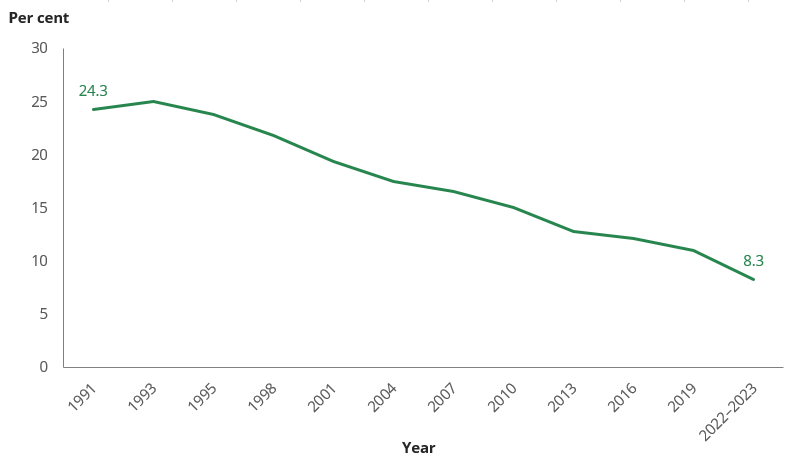
Source: NDSHS 2022–2023, Table 2.1.
Who was most likely to smoke?
As in previous surveys, males were more likely to smoke daily (9.0%) than females (7.7%) in 2022–2023. Positively, daily smoking decreased for both males and females between 2019 and 2022–2023, so in both years males were 1.2 times as likely as females to smoke daily.
Between 2019 and 2022–2023, daily smoking decreased among all age groups from 18–24 through to those aged 50–59. Only those aged 60–69 and 70 and older did not see substantial decreases in the daily smoking rate (Figure 2).
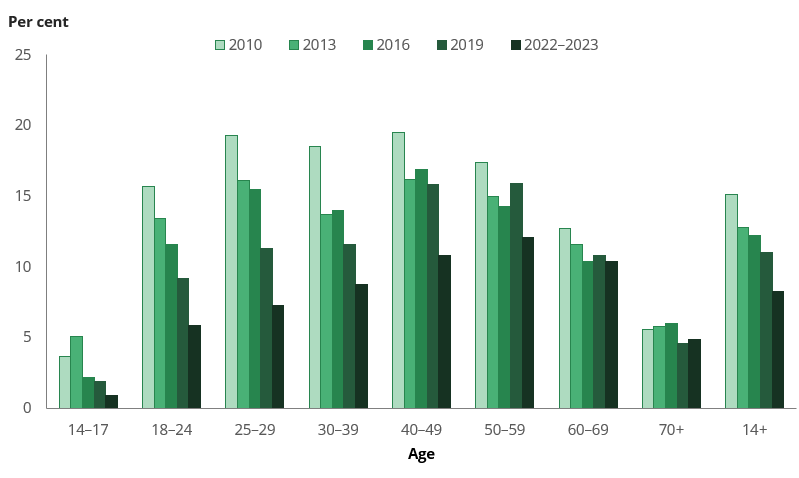
Source: NDSHS 2022–2023, Table 2.4.
As a result, people who smoke were older in 2022–2023 than ever before. 1 in 5 (20%) people who smoke were in their 40s in 2022–2023 (similar to 19.8% in 2001), 19.5% were in their 50s (up from 13.4% in 2001) and 14.4% were in their 60s (up from just 5.8% in 2001).
People who lived in the areas of most socioeconomic disadvantage were the most likely to smoke daily, with 13.4% doing so in 2022–2023. In general, areas with higher socioeconomic advantage had lower proportions of people smoking daily, with the lowest level of smoking prevalence (4.1%) occurring in the areas of most socioeconomic advantage.
Positively, there was a substantial decrease in the level of daily smoking in the most disadvantaged socioeconomic areas between 2019 (18.1%) and 2022–2023 (13.4%). People living in those areas were 3.3 times as likely as those living in the most advantaged socioeconomic areas to smoke daily, down from 3.6 times as likely in 2019 (Figure 3).
There was no change in the daily smoking rate between 2019 and 2022–2023 for people living in Remote and Very remote areas, while reductions occurred in Major cities, Inner regional areas and Outer regional areas. As a result, people living in Remote and Very remote areas were 2.9 times as likely to smoke daily (20%) as people in Major cities (7.0%), an increase from 2019 when they were 2.0 times as likely to do so.
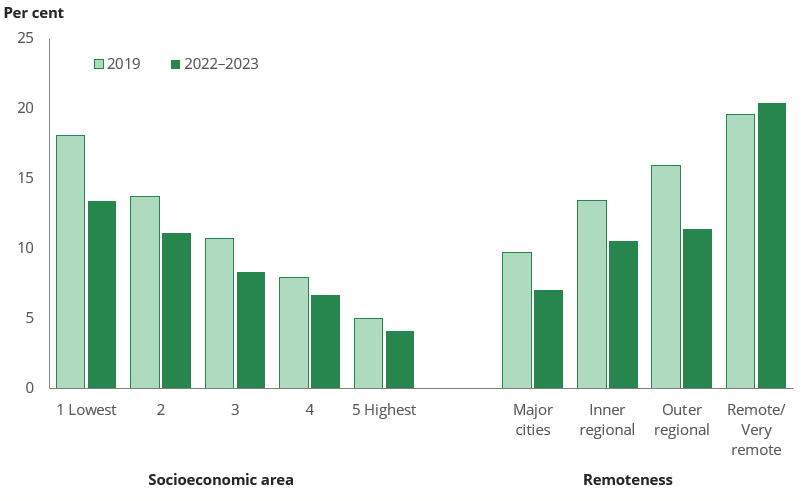
Source: NDSHS 2022–2023, Table 2.11.
Gay, lesbian and bisexual people were more likely to smoke daily than heterosexual people in 2022–2023 (14.2% compared with 8.2%). After adjusting for differences in age, gay, lesbian and bisexual people were 2.0 times as likely to smoke daily as heterosexual people.
1 in 5 Aboriginal and Torres Strait Islander (First Nations) people smoked daily in 2022–2023, and after adjusting for differences in age, First Nations people were 2.6 times as likely as non‑Indigenous people to smoke daily in 2022–2023.
How many people who smoke used menthol cigarettes?
New tobacco policies in Australia
From 1 April 2024, new public health legislation will begin (Mark Butler 2023). This legislation introduces new regulations to discourage smoking, including banning tobacco containing menthol. Menthol is a flavouring added to tobacco to make it more palatable. It also contributes to increased nicotine dependence (Alsharari et al. 2015).
National Drug Strategy Household Survey data was collected in 2022 and 2023, prior to these restrictions being implemented. Results should be considered a benchmark of use of menthol cigarettes before additives are banned, and a measure of how many people who smoke are likely to be impacted by such a ban.
For the first time in 2022–2023, the National Drug Strategy Household Survey asked people who smoked about their use of menthol cigarettes. Among everyone who smokes, 31% had used menthol cigarettes (manufactured or roll-your-own) in the previous 12 months. However, menthol cigarettes were more popular among people who smoked less frequently:
- Only 29% of people who smoked daily had used menthol cigarettes, although 23% of people who smoked daily reported using menthol cigarettes every day.
- 35% of people who smoked weekly (but not daily) had used menthol cigarettes. 26% of them used them every week.
- 43% of people who smoked less often than weekly reported using menthol cigarettes.
Prohibiting additives such as menthol in cigarettes is likely to have a greater impact on people who smoke less frequently, such as weekly (but not daily) and less often than weekly, although it is also likely to also have an impact on almost 1 in 4 (23%) people who smoke every day.
How many people were exposed to tobacco smoke at home?
In 2022–2023, 78% of households with children aged 14 and under reported that no-one at home regularly smoked, an increase compared with 2019 (74%) and 2001 (55%). Only 2.1% of households with children aged 14 and under had someone at home who smoked inside the house, similar to 2019 but a large reduction from the 19.7% of households in 2001 (Figure 4).
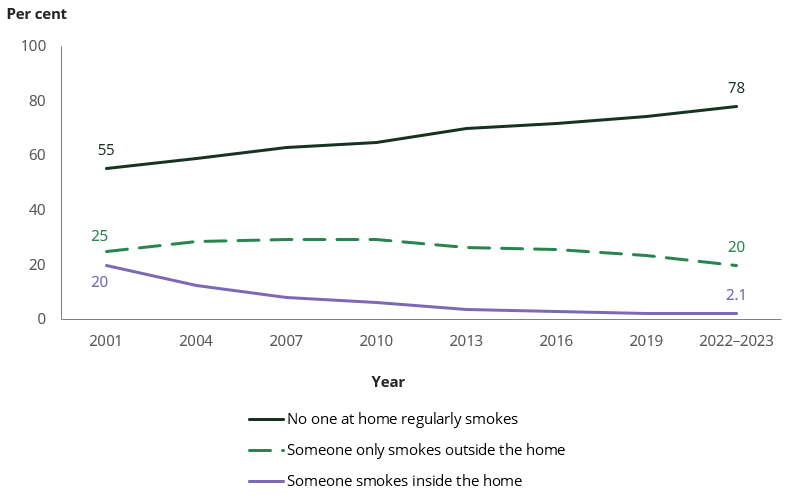
Source: NDSHS 2022–2023, Table 2.14.
Did people who smoke try to quit or reduce their smoking?
In 2022–2023, over the previous 12 months, nearly 3 in 10 (28%) people who smoke tried to quit but were not successful. 2 in 10 (19.8%) were able to quit for more than one month and 4 in 10 (39%) reduced the amount of tobacco they smoked in a day.
The cost of smoking remained most common factor that motivated people to quit or cut back on their smoking (53%), although the proportion of people selecting cost did decrease from 2019 when 58% did so. Nearly half (45%) were motivated to try quitting because they thought that smoking was affecting their health or fitness, the same as in 2019.
The majority of people who smoke (62%) took part in at least 1 activity to help them quit or cut down on their smoking in 2022–2023. The top 5 activities were:
- Attempting to quit by going cold turkey (that is, cutting out all nicotine), 24%.
- Using e‑cigarettes to help cut down on smoking regular tobacco cigarettes, 19.6% (up from 14% in 2019).
- Discussing smoking and health at home, 18.9% (down from 22% in 2019).
- Using nicotine gum, nicotine patch, inhaler, or spray, 16.9%.
- Using e‑cigarettes to help quit smoking regular tobacco cigarettes, 12.2% (up from 8.0% in 2019).
While most people who smoke (67%) would like to quit smoking and intend to at some point in the future, some have no intention to give up smoking. In 2022–2023, 1 in 3 people who smoke (33%) said they did not intend to quit, an increase from 2019 when 30% did not intend to quit (Figure 5). When asked why they had no intention of quitting, 59% reported that they enjoyed smoking, while 46% said that smoking relaxed them and 24% said that they were addicted to nicotine.
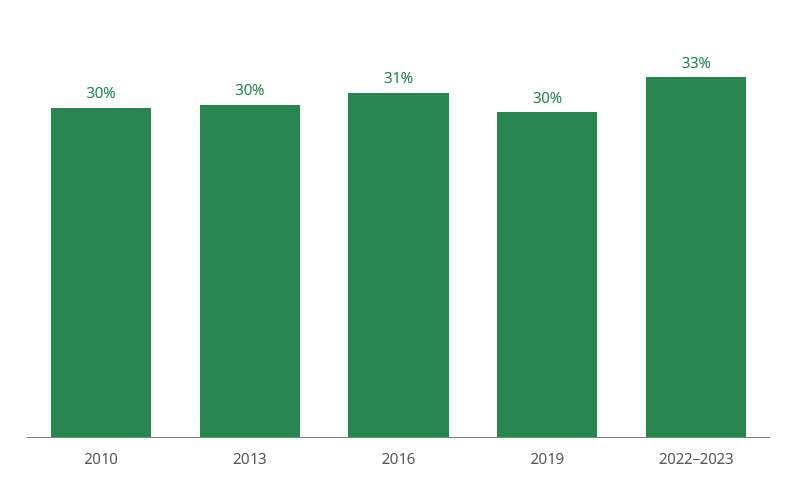
Note: Data is limited to people who reported smoking daily, weekly and less than weekly.
Source: NDSHS 2022–2023, Table 2.39.
How do people think about tobacco in relation to other drugs?
Although tobacco use remains the leading risk factor contributing to disease burden and deaths in Australia (AIHW 2021), public concern about tobacco has declined since 2007. In 2022–2023, the proportion of people who perceived tobacco as the drug that causes the most deaths was 17.4%, a substantial drop from the 40% of people who selected tobacco in 2007. Less than 1 in 10 (7.8%) people regarded tobacco smoking as the most serious concern for the general community, down from 17.2% in 2007 (Figure 6).
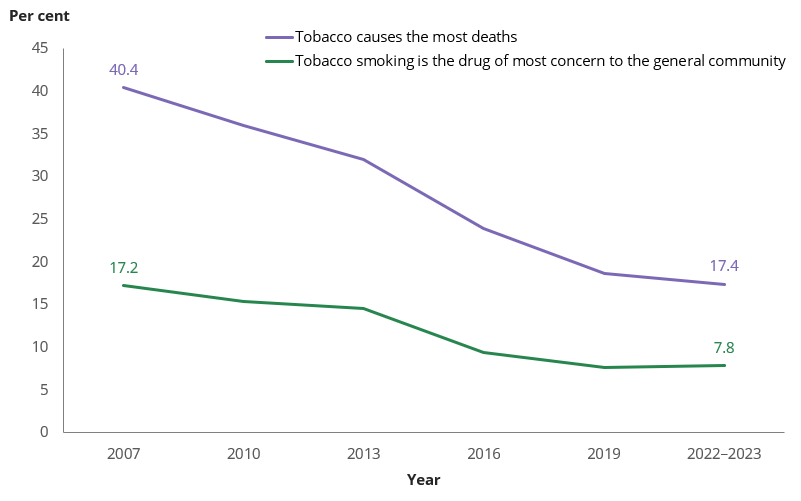
Source: NDSHS 2022–2023, Tables 11.3 and 11.5.
The proportion of people who approve of the regular use of tobacco remained stable between 2019 and 2022–2023, with 15.5% of people doing so. This was lower than the proportion of people who approved of the regular use of cannabis by an adult (23%).
Support for tobacco policies remained high
The level of support for the following tobacco policies increased between 2019 and 2022–2023:
- Banning all additives in cigarettes to make them less attractive to young people (78%, up from 74% in 2019).
- Implementing a national licensing scheme for tobacco retailers (68%, up from 67%).
- Raising the legal age for sale or supply of tobacco products to those aged 21 years and over (65%, up from 63%).
- Making it harder to buy tobacco in shops (65%, up from 61%).
Policy options relating to increasing tax on tobacco products remained stable between 2019 and 2022–2023, with support ranging from 64% to 68% across the different purposes of increasing the tax.
Two new tobacco policy measures were asked about in 2022–2023:
- Around 4 in 5 people (81%) supported banning the advertising of tobacco products on social media, making it the most supported policy measure related to tobacco use.
- Just over 1 in 2 people (53%) supported banning the sale of tobacco products in places where people are consuming alcohol, making it the least supported policy measure related to tobacco use.


